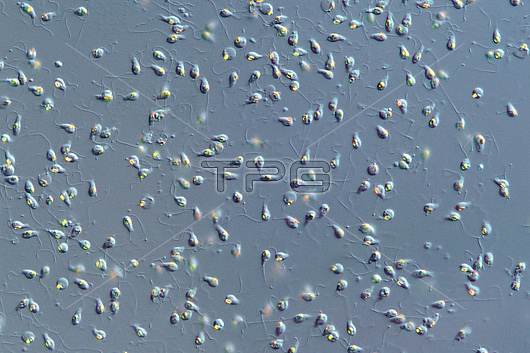
Male reproductive cells (antherozoids) of bladderwrack (Fucus vesiculosus) seaweed, light micrograph. Bladderwrack is a brown seaweed (Phaeophyceae) very common on the North Atlantic coast, found in the tidal range. Bladderwrack is a dioecious species, with distinct male and female stems. Their reproductive organs produce male gametes (antherozoids) and female gametes (oospheres). The release of sex cells into the marine environment enables these genetically complementary cells to meet and unite during fertilisation. Fertilisation of an oosphere by an antherozoan results in the formation of an egg-cell, followed by the formation of a rockweed embryo. This can be recognised by the gradual emergence of a lateral extension that will later become an attachment organ. The embryo eventually clings to a rocky substrate, and the new algal plant, tiny at first, begins its new life in a fixed state. The microphotograph shows an isolated Fucus egg-cell (or zygote), just after fertilisation of the oosphere with an antherozoon. The thin surrounding wall attests to fertilisation (compare with an isolated Fucus oosphere). Magnification: x450 when printed at 10 centimetres wide.
| px | px | dpi | = | cm | x | cm | = | MB |
Details
Creative#:
TOP30268435
Source:
達志影像
Authorization Type:
RM
Release Information:
須由TPG 完整授權
Model Release:
N/A
Property Release:
N/A
Right to Privacy:
No
Same folder images:

 Loading
Loading